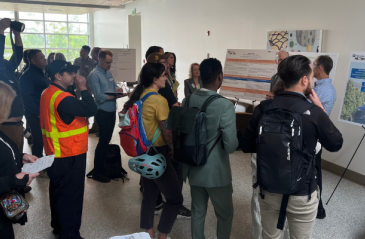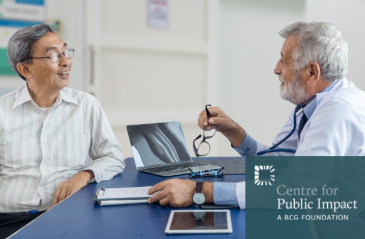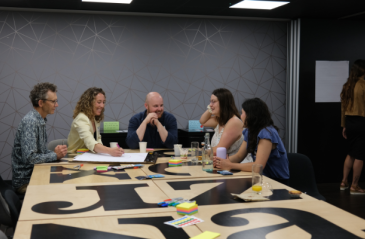
The information barriers holding back climate action and how to break them

The world's largest clinical trial on preventing arthritis, explains @MarkSamuelsNIHR
Share article36 universities and hospitals are now work together as one team to help prevent arthritis
Share articleIt can be challenging to establish large-scale collaborations but the potential results are huge
Share articleWe put our vision for government into practice through learning partner projects that align with our values and help reimagine government so that it works for everyone.
I've always pushed myself - trying to reach my limits and then pushing a bit further. This has seen me climb the Eiger, scale previously unclimbed peaks in the Tien Shan, and negotiate the tight hairpins of the Stelvio Pass on my motorbike. I live for pulling off demanding challenges and seek this sense of achievement in the workplace, too.
Now, despite my childhood dreams, I am not an astronaut. I am the managing director of the Office for Clinical Research Infrastructure within the National Institute of Health Research (NIHR). But when we secure large-scale collaborations that can lead to major medical breakthroughs, the thrill and achievement is very much there. For example, when we had kicked off the world's largest clinical trial on preventing rheumatoid arthritis, the sense of excitement and satisfaction in our offices was palpable.
Rheumatoid arthritis affects more than 500,000 people in the UK and over a billion people worldwide. Achieving these types of numbers is what empowers and drives the work of the NIHR, which is responsible for clinical research in the NHS across England. With an annual budget of over £1 billion, it is the world's second-largest government funder of health research. However, it wasn't always this way.
I was the first person to take up the role of managing director of the newly established NIHR Office for Clinical Research Infrastructure. In the weeks before I started work, I was warned by my friends and colleagues not to take on the job. Although the government was keen to encourage investment by companies into health research, the closures of leading R&D facilities such as Pfizer's in Sandwich, Kent and the Novartis site in Horsham, West Sussex underlined the scale of the challenge. I had to reverse these trends by establishing a robust infrastructure for health research in England that would undertake experimental medicine on the scale of our current arthritis trial. So how did I go about it?
The first thing I sought to do was bring together our array of research centres, of which there were many. The combined strength of the universities of Oxford, Cambridge, and Imperial College, London - to name but three - would offer unmatched intellectual firepower. Unfortunately, combining them was easier said than done. Attempts had previously been made to bring such institutions together, but it had proved difficult, not least because such institutions have traditionally competed against each other - for the best students, the best teachers and, of course, on the sporting field. The whole university system drives competition.
But nonetheless I pressed on, seeking to persuade them of the benefits of greater collaboration - which is how the arthritis research has come about. I have had to get 36 universities and hospitals to work together as one team and to do so at speed, because one of the criticisms from the pharmaceutical industry was that the UK's bureaucracy moved too slowly.
To start with, we only had four people in our team and we were camping out in temporary offices in Whitehall. But we did it - we brought together the universities and NHS Trusts to sign a legal commitment to work together as a team, which in itself was unique and pioneering. But in a way, that was the easy part - we then had to get them to deliver.
Even though the industry had asked for these partnerships to be set up - and we had, against the odds, succeeded in doing so - they remained sceptical about the merits of working in the UK. But we began to make progress, starting with the medium-sized firms. For the first company to engage with us, we had to sign a non-disclosure agreement to protect their intellectual property, which all 36 universities and hospitals did in a couple of weeks - much to the surprise of the company's lawyers - and this gave us some welcome extra credibility.
Thanks to efforts like this, we were able to gain a sense of shared ownership - not only with the top academics and researchers but right across the organisation. This type of collaboration involves close work with people on every level, at the operational end as well as in the centre. We had strong interconnections between policy and delivery - not always common in government - which ensured that insight from the frontline underpinned and influenced all of the strategic decisions.
An example of this was when a leading medical academic involved in the partnership made an important suggestion. If we were to trial the prevention of arthritis, we needed to study people who did not have the disease but were at high risk of getting it. The only way we could do this was through a massive research consortium - such as the one we had already established - because you need a large patient population from which to identify these individuals.
Our approach was that my team was responsible for the overall coordination and management of the trial, but each of our research centres was empowered to play its part and lead academically. So we were like the conductor of the orchestra while the centres took the lead in the science, in identifying the individuals, and in running the research.
By bringing together these previously disparate centres, we are enabling drugs that would previously have lain dormant on the laboratory shelf to have a beneficial effect on citizens' health. They will help people recover from many illnesses and conditions, rheumatoid arthritis among them. It can be challenging to establish these large-scale, often global, collaborations but it gives me great satisfaction to rise to that challenge and help ensure that these groundbreaking trials can go ahead. As public impact goes, that's something to be proud about.











